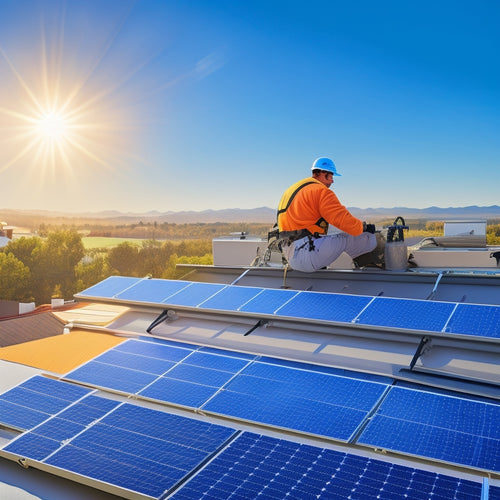
Solar Panel Hook Up in 3 Easy Steps
Share
You'll need to prepare your roof and wiring by verifying its structural soundness, inspecting for damage, and installing dedicated electrical circuitry. Next, you'll connect your solar panels together, choosing between series or parallel configurations based on your system's requirements. Finally, you'll hook up to the electrical grid by connecting your panels to an inverter, which converts DC power to AC, and then linking it to a net meter to measure energy production and feed-in; from here, you can examine the specifics of each step to guarantee a safe and efficient solar panel setup.
Key Takeaways
- Ensure your roof is structurally sound and clear of debris before installing solar panels.
- Choose the right connection configuration (series or parallel) based on your system's requirements.
- Connect your solar panel array to the electrical grid using an inverter and net meter.
- Select the right inverter type (string, microinverter, or power optimizer) for your system.
- Properly insulate and secure all connections to ensure safety and maximize energy production.
Prepare the Roof and Wiring
Roof preparation and wiring setup are essential precursors to a successful solar panel installation.
You'll need to verify your roof is structurally sound and can support the weight of the solar panels. Conduct a thorough roof inspection to identify any damaged, rotten, or missing shingles, and repair or replace them as needed. Clear the roof of debris, and trim any tree branches that may be obstructing sunlight.
Next, focus on wiring safety. Your solar panel system will require a dedicated electrical circuit, so you'll need to run new wiring from the roof to your electrical panel.
Verify the wiring is rated for outdoor use and can handle the DC power output from the solar panels. Make sure to follow local electrical codes and regulations, and consider hiring a licensed electrician if you're not comfortable with the wiring process.
Proper wiring setup is vital to preventing electrical shocks, fires, and other safety hazards. By taking the time to prepare your roof and wiring, you'll be well on your way to a safe and efficient solar panel installation.
Connect Solar Panels Together
As you move forward with your solar panel installation, it's now time to connect the individual panels together to form a cohesive array. You'll need to decide on the connection configuration that suits your system best. You have two options: series connections or parallel connections.
In a series connection, the positive terminal of one panel is connected to the negative terminal of the next panel. This configuration increases the voltage of your system, making it ideal for systems with high voltage requirements. However, if one panel is shaded or malfunctioning, the entire string will be affected.
In a parallel connection, all positive terminals are connected together, and all negative terminals are connected together. This setup increases the current of your system, making it ideal for systems with high current requirements. The advantage of parallel connections is that if one panel is shaded or malfunctioning, the other panels will continue to operate normally.
Consider your system's requirements and choose the connection configuration that best suits your needs.
Hook Up to Electrical Grid
Now that you've configured your solar panel array, you're ready to hook it up to the electrical grid. This connection allows you to feed excess energy back into the grid and offset your electricity consumption.
To do this, you'll need an inverter, which converts DC power from your solar panels to AC power compatible with the grid.
There are several inverter types to choose from, including string inverters, microinverters, and power optimizers. String inverters are the most common, but microinverters offer more flexibility and monitoring capabilities. Power optimizers provide a compromise between the two.
Once you've selected an inverter, you'll need to connect it to a net meter. This meter measures the energy you produce and feeds it back into the grid.
You'll receive net metering benefits, such as credits for excess energy produced, which can offset your energy consumption during periods of low solar production.
With your inverter and net meter in place, you're ready to start generating clean energy and reducing your reliance on the grid.
Frequently Asked Questions
What Is the Ideal Roof Direction for Solar Panel Installation?
As you traverse the world of solar power, you'll find that a south-facing roof orientation is the golden ticket to maximizing solar efficiency, with a deviation of up to 20 degrees east or west still yielding ideal results.
Can I Install Solar Panels on a Metal Roof?
You can install solar panels on a metal roof, leveraging its benefits like durability and water-tightness, but be prepared to address installation challenges like securing panels to the roof's ridges and ensuring a watertight seal around mounting hardware.
How Much Does a Typical Residential Solar Panel System Cost?
You're considering utilizing the sun's energy, and you're wondering, "How much will it set me back?" A typical residential solar panel system costs between $15,000 and $30,000, but with solar financing options, you can reap solar installation benefits without breaking the bank.
Do Solar Panels Generate Electricity During Power Outages?
You'll find that solar panels don't generate electricity during power outages, unless you've invested in a battery storage system, which can provide backup power; however, solar panel efficiency remains high, even during grid outages, if you've opted for a grid-tie system with energy storage.
Are There Any Government Incentives for Solar Panel Installation?
As you commence on your solar expedition, imagine utilizing the sun's energy like a treasure chest overflowing with benefits. You'll uncover federal tax incentives and state rebates waiting to be revealed, helping you power your home and pad your wallet simultaneously.
Related Posts
-

3 Best State and Local Solar Incentives USA
You can greatly reduce your energy dependence and save thousands of dollars by taking advantage of the top state and ...
-

What Makes a Road Bike-Friendly by Design?
As you plan and design roads, incorporating features like dedicated bike lanes, smooth surfaces, and traffic calming ...
-

3 Essential Steps for Solar Electricity Installation
To guarantee a successful solar electricity installation, you'll need to follow three essential steps. First, assess ...


